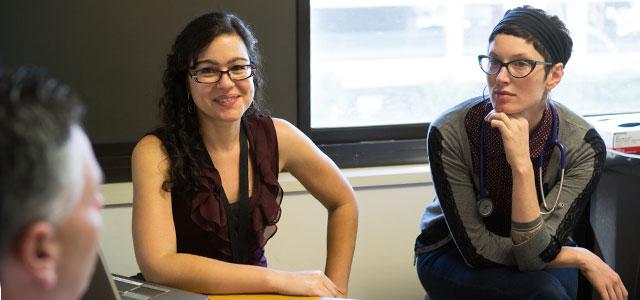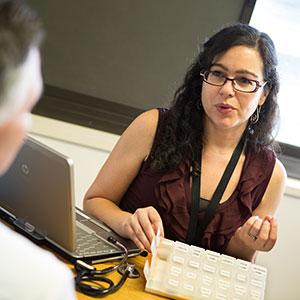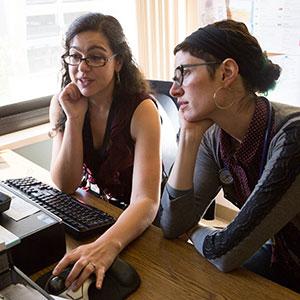
Veronica Ramirez (center) and master’s student Sarah Beth Bailey with a patient at the East Bay AIDS Center (photos by Elisabeth Fall)
What Preceptors Do: Veronica Ramirez at the East Bay AIDS Center
Volunteer clinical faculty and preceptors offer students individual perspectives and hands-on experience in a variety of health care settings and specialties. The cumulative effect of what these volunteers impart plays a significant role in the care any health system delivers. This series aims to shed light on the unique roles these valuable mentors play.
This month we hear from Veronica Ramirez, adult nurse practitioner at the East Bay AIDS Center.
Getting to Nursing
I’m a born and bred Bay Area gal, but my dad was in the Coast Guard and I also lived in Hawaii and Massachusetts. I had a lot of challenges with my family life, and I wound up in a couple of foster homes for a while.
Eventually, I got a degree in psychology at San Francisco State, which gave me more tools to explore my past. A pivotal point was when I started volunteering for St. James Infirmary, an occupational health and safety clinic for sex workers; I’ve had a long relationship with St. James ever since. I moved from registration work to outreach, HIV test counseling and STD counseling, and ended up working with a hepatitis C study on men who had sex with men and injected drugs. It all seemed to fit my interest in marginalized populations, women’s rights and human rights as a woman, a woman of color and someone from a less affluent background. I’m a first- and second-generation American. Both of my brothers happen to be gay.
The work at St. James led to my working as a family-planning counselor in women’s health at San Francisco General Hospital in the Women’s Options Center, where I wound up taking on a lot of nursinglike duties. At that point, it seemed like nursing ticked all the boxes for me, so I decided on that as a career, got some prerequisites done and entered the MEPN program at UCSF. In deciding what specialty to pursue for my master’s, I considered it a toss-up between women’s health and HIV. I chose HIV not only because it has a medical component, but also because it’s linked with the psychosocial issues I’m interested in: substance use, poverty, mental health disorders.
Once I began the master’s program, I spent half of my primary care time at the East Bay AIDS Center, so I felt prepared when I got my degree and began working at Berkeley Primary Care, where they have a small HIV program. That was a blended RN and NP (nurse practitioner) role – a really good first step.
Working as an HIV/AIDS NP
 Was I still afraid when I began as an NP at the East Bay AIDS Center? Sure. Any new NP probably has some concerns about how proficient they are, but UCSF helped me identify my resources and how to use them appropriately. I knew I wouldn’t know everything, but I did know how to get the consultation I needed. Also, UCSF clinical faculty member Deborah Royal was my preceptor at the East Bay AIDS Center, and I learned a lot from her and from others.
Was I still afraid when I began as an NP at the East Bay AIDS Center? Sure. Any new NP probably has some concerns about how proficient they are, but UCSF helped me identify my resources and how to use them appropriately. I knew I wouldn’t know everything, but I did know how to get the consultation I needed. Also, UCSF clinical faculty member Deborah Royal was my preceptor at the East Bay AIDS Center, and I learned a lot from her and from others.
Now I’ve been back at the East Bay AIDS Center a little over two years as one of the primary care providers. We’ve recently been working more toward a team model of care, with MDs, NPs, an RN, a social worker and a medical assistant on each team; and we’re trying to get pharmacists as well. We’ve also started case-conferencing (among the teams) for more acute or problematic cases, so we can coordinate care better.
Of course, we always check in about HIV with our positive patients, but for a lot of them, HIV isn’t their primary issue. For high-functioning patients, who have their HIV well controlled, we do maintenance and health promotion mostly. Others might have their HIV well controlled but are struggling with other chronic diseases, like hepatitis and diabetes. Then there are other folks who are marginally engaged in care and can be difficult to reach, who are often living in poverty and have mental health issues.
I think my background helps with all of them, because I can see a little more of where the patients are coming from. Every story is different, but maybe I have a little more of an inkling: I’ve been through the system, I know the challenges, and I’m very comfortable working with people with mental illness and substance use problems. It’s a combination of personality, training and experience. I look at the whole person and not just one aspect of their health.
What made a difference for me – in my ability to be resilient – was having a connection with someone who cared for me and believed I could be and do better. I’m a health care provider, so there are limitations, but I definitely come from a place of caring for them and believing they can be more and do more, and that’s the lens through which I speak with them. I help them think about there being other ways of living and that nothing is impossible.
For example, some patients think, “I’m positive, so I can’t have kids.” They absolutely can, but let’s talk about how to do it safely so they can have the outcome they want. That’s one of the things I like about working with HIV patients: I can give them hope – and help them to get past that stigma and fear around HIV. It’s not a death sentence. They can have career and a life they want. I also like that I can make a difference in the communities I care about. I live here in Oakland, and my family is still in the Bay Area.
The biggest challenge is working with the systems. We work closely with UCSF Benioff Children’s Hospital Oakland and their infectious disease program because we have a fair number of perinatally infected kids, and when they get older, they transition to care here or at other clinics. They’re difficult to manage, because they’ve been told all their life they’d die without meds and they’re still alive, so now they don’t want to take the medications anymore. Many of them have a kind of PTSD from medical settings; they don’t want to be poked and prodded. And before the Affordable Care Act, their Medi-Cal would just get cut off at age 21, which made it very difficult to treat them.
On Precepting
 I’ve worked with students before informally, but this year is my first time having my own student. I’m encouraging the student to think about how to relate to the patients, because if the patients are not comfortable, they won’t share very important information. If you get too focused on one aspect of care and don’t establish that therapeutic rapport, you won’t get the whole picture and won’t be able to make any movement.
I’ve worked with students before informally, but this year is my first time having my own student. I’m encouraging the student to think about how to relate to the patients, because if the patients are not comfortable, they won’t share very important information. If you get too focused on one aspect of care and don’t establish that therapeutic rapport, you won’t get the whole picture and won’t be able to make any movement.
In establishing that rapport, I try to monitor my use of medical jargon and speak in a more informal manner, so I don’t come from this elitist position. On the other hand, in this position you still have to come off as an authority. There are other times in my life I looked a bit different. I used to have my septum pierced, and my hair was bright red, but I try to look more formal here, because people treat you differently depending on how you look.
I have one gal (not yet 21) who, when she first came, was so shut down, she barely spoke a word. I validated that she was there, made it clear that she is the person in power, but at first she wasn’t open to communicating. Now she comes in regularly, is on her meds and takes them without fail. Her T cells have rebounded, and she opened up that she primarily identifies as lesbian but was raped, and that’s how she got HIV. She was so angry that she just couldn’t talk for a while. We’re still working on getting her comfortable doing a Pap smear with me, but she’s really done a turnaround.
And I know I need to both say it and model it for the students. I come in with a smile on my face, greet the person and ask how they’re doing. Sometimes it just takes some time until the patients know that you’re on their side. You work for them. They are directing their care. I have recommendations, but it’s up to them to decide if they’re interested. Sometimes they are and sometimes they’re not, and I have to be okay with that. They’re more likely to listen if they really feel like you’re on their side – and demonstrating that over and over again will bring them around.



